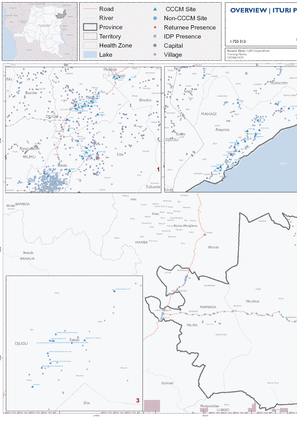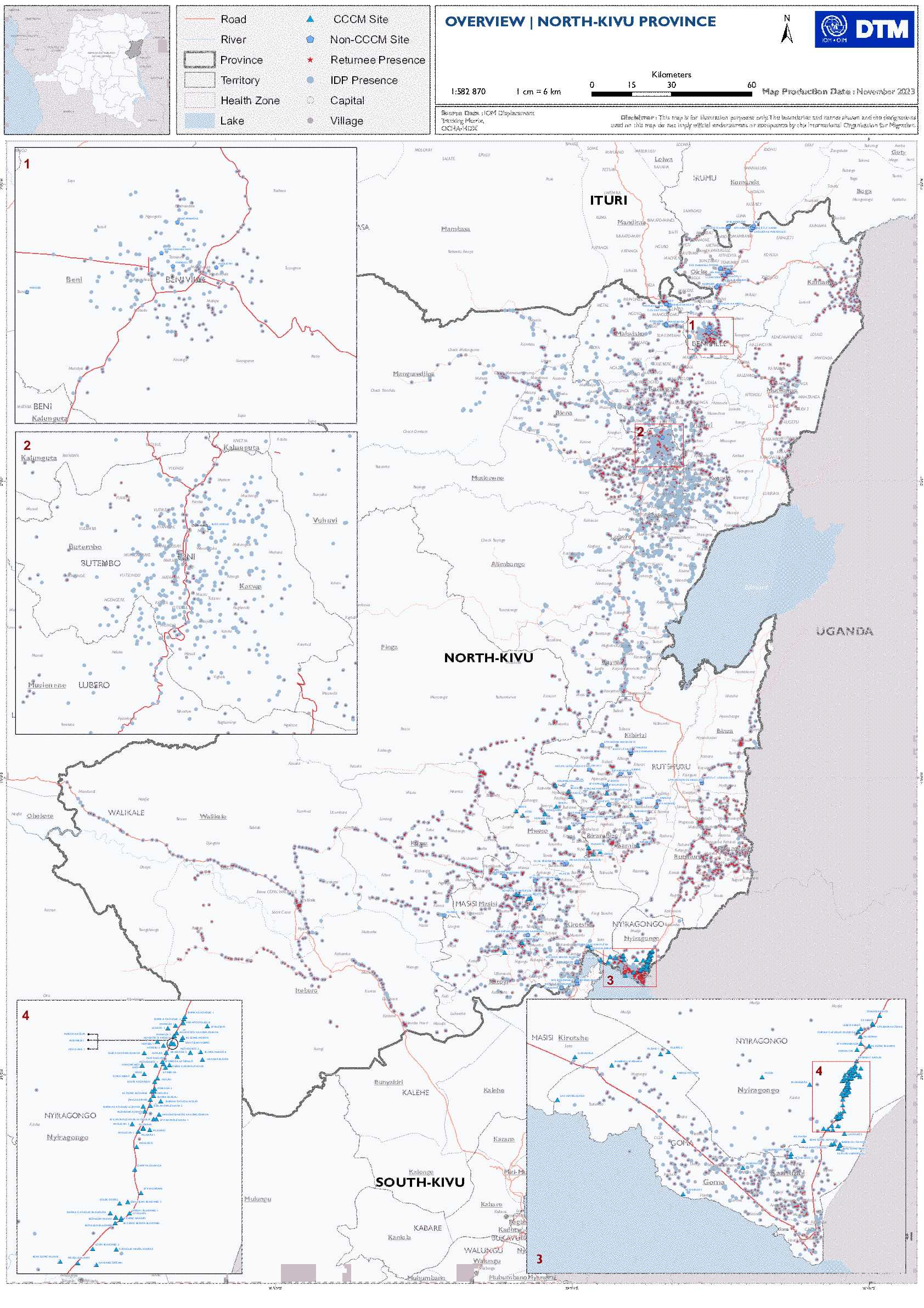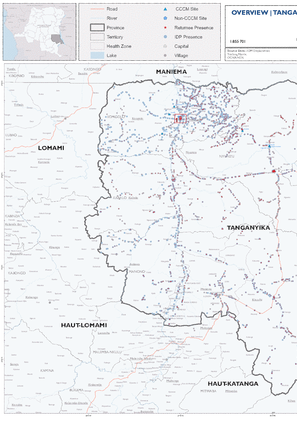-
Countries
-
Data and Analysis
-
Special Focus
-
Crisis Responses
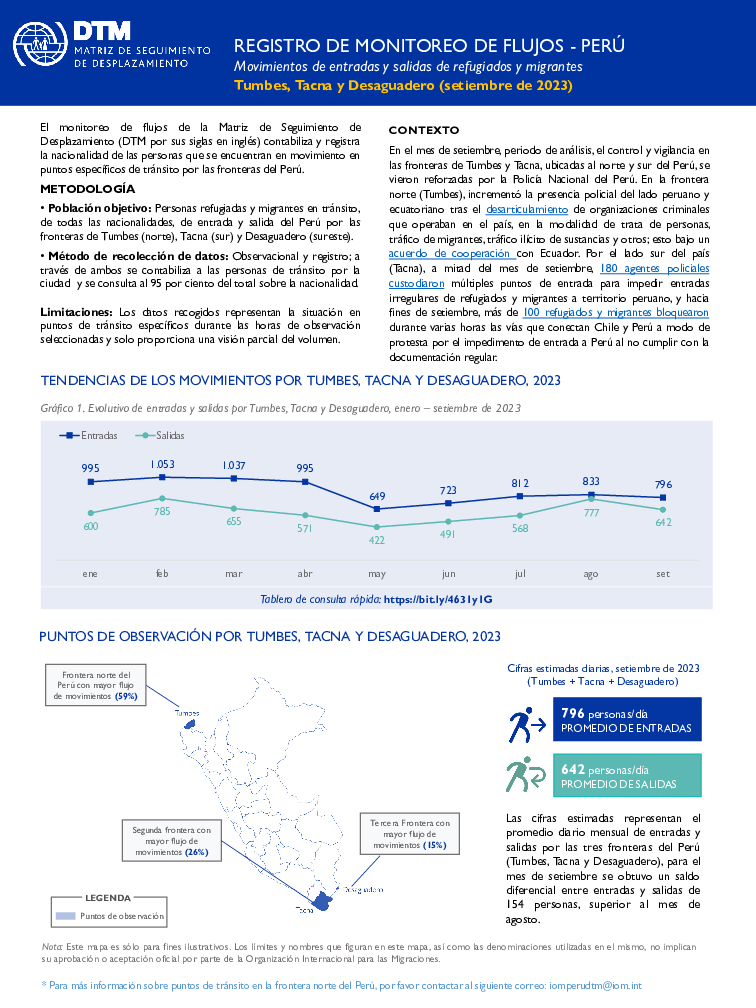
Contact
DTM Peru, IOMDTMPeru@iom.int
Language
Spanish
Location
Peru
Period Covered
Sep 06 2023
Sep 29 2023
Activity
- Flow Monitoring
En el mes de setiembre, periodo de análisis, el control y vigilancia en las fronteras de Tumbes y Tacna, ubicadas al norte y sur del Perú, se vieron reforzadas por la Policía Nacional del Perú. En la frontera norte (Tumbes), incrementó la presencia policial del lado peruano y ecuatoriano tras el desarticulamiento de organizaciones criminales que operaban en el país, en la modalidad de trata de personas, tráfico de migrantes, tráfico ilícito de sustancias y otros; esto bajo un acuerdo de cooperación con Ecuador. Por el lado sur del país (Tacna), a mitad del mes de setiembre, 180 agentes policiales custodiaron múltiples puntos de entrada para impedir entradas irregulares de refugiados y migrantes a territorio peruano, y hacia fines de setiembre, más de 100 refugiados y migrantes bloquearon durante varias horas las vías que conectan Chile y Perú a modo de protesta por el impedimento de entrada a Perú al no cumplir con la documentación regular.

Contact
San Jose Regional Data Hub — rosanjosermdh@iom.int
Language
English
Location
Dominica
Period Covered
Aug 30 2023
Sep 02 2023
Activity
- Survey
- Baseline Assessment
Dominica’s location in the Caribbean has made it particularly susceptible to natural hazards and disasters such as hurricanes. There is a substantial need for up-to-date data on population size and the distribution of citizens and migrants in the country, to inform disaster risk reduction and preparedness. The latest government population census was conducted in 2011, and with the 2022 census still ongoing, more recent information on the characteristics of the migrant population is required to prepare the population for natural hazards and disasters.
To better understand the distribution of the migrant population within the country, IOM conducted a Rapid Baseline Assessment (RBA), between 30 August - 2 September 2022. The exercise consisted of a series of key informant (KI) interviews in the 10 parishes of the Commonwealth of Dominica to obtain information on migrant presence and their main characteristics. Among the interviewed KIs were government officials, community leaders and community members from their respective parishes. This information was then utilized to build the methodology and sampling frame for a DTM national survey on migrant sociodemographic characteristics, their main needs and intentions.

Contact
DTMUkraine@iom.int
Language
English
Location
Ukraine
Period Covered
Sep 03 2023
Sep 25 2023
Activity
- Survey
Between 3 and 25 September 2023, the International Organization for Migration (IOM) conducted Round 14 of the General Population Survey (GPS), a highly representative assessment of return in Ukraine. This report gathers information on population figures, return flows and mobility intentions, demographic profiles, areas of return and places of last displacement, household composition and vulnerabilities, and needs of returnee populations
Round 14 continues continues to focus on durable solution pathways and sustainable return along criteria proposed by the Inter-Agency Standing Committee Framework on Durable Solutions for IDPs (IASC). This report also includes new sections on winterisation and participation in public affairs. The General Population Survey was constructed through interviews with 20,000 respondents using the computer-assisted telephone interview (CATI) method, and a random digit dial (RDD) approach.

Contact
DTM DRC, iomdrcdtm@iom.int
Language
French
Location
Democratic Republic of the Congo
Period Covered
Aug 03 2023
Sep 12 2023
Activity
- Mobility Tracking
- Baseline Assessment
Compte tenu de la nécessité de disposer d'informations précises et agréées par les autorités, l'OIM, par le biais de la matrice de suivi des déplacements (DTM), a mené des évaluations de suivi de la mobilité (Mobility Tracking - MT en anglais) depuis 2018. Ces exercices sont mis en œuvre en RDC dans le but de fournir des estimations sur la présence, le nombre de groupes de population affectés (PDI, personnes retournées), les raisons du déplacement, la durée du déplacement et les besoins spécifiques dans des lieux définis. Les données pour l'exercice MT sont collectées sur une base semestrielle par des équipes d'enquêteurs formés, par le biais d'entretiens avec des informateurs clés et d'observations directes au niveau des villages. Au cours de ce processus, l'OIM s'assure de la participation des représentants du gouvernement pendant la collecte des données afin de promouvoir et de renforcer les capacités dans l'éventualité d'un transfert. Les données de l'OIM sont ensuite présentées et validées par la Commission de mouvement de population (CMP) de la province.
Les statistiques synthétiques présentées dans ce rapport sont obtenues à partir du cycle de MT le plus récent pour chaque province, qui s'est déroulé entre août et septembre 2023, afin de produire une vue d'ensemble de la situation du déplacement dans la région de l'est de la RDC. Les chiffres concernant les individus déplacés en raison de la crise du M23 sont extraits de la dernière analyse de la crise du M23.
Dans les quatre provinces de l'Est de la RDC, comprenant l'Ituri, le Nord-Kivu, le Sud-Kivu et le Tanganyika, DTM a identifié 5 637 536 personnes déplacées et 4 324 523 personnes retournées, présentes dans 76 pour cent des villages évalués. DTM estime que la plus grande proportion (41%) de personnes déplacées (2 300 163 individus) est installée au Nord-Kivu, suivie par 29 pour cent (1 630 535) en Ituri, 24 pour cent (1 356 376) au Sud-Kivu et 6 pour cent (350 462) au Tanganyika. Les raisons de déplacement les plus fréquemment rapportées par les populations déplacées résidant dans des familles d'accueil sont les attaques de groupes armés (84%), les conflits intercommunautaires (12%) et les catastrophes naturelles (3%). Il est estimé que 908 920 personnes ont été déplacées par la crise du M23 au moment de la dernière analyse de crise de la DTM.
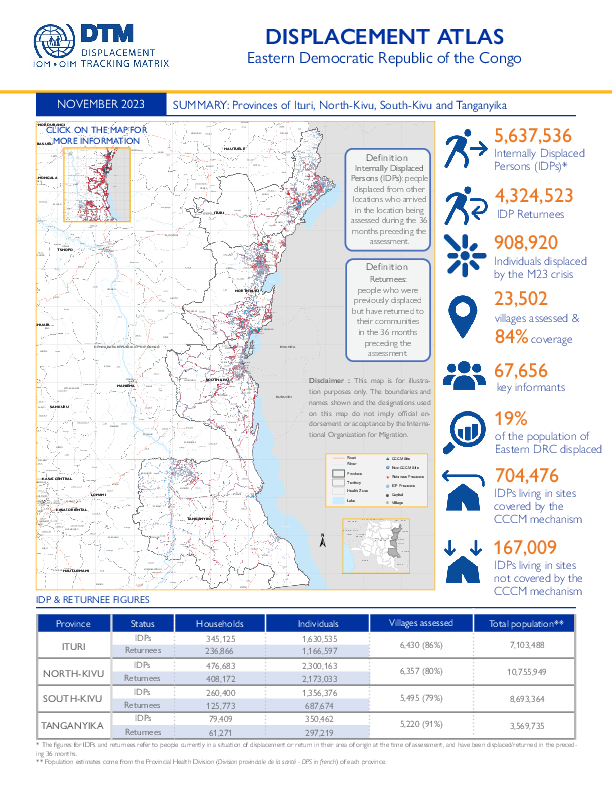
Contact
DTM DRC, iomdrcdtm@iom.int
Language
English
Location
Democratic Republic of the Congo
Period Covered
Aug 03 2023
Sep 12 2023
Activity
- Mobility Tracking
- Baseline Assessment
IOM DRC - through its Displacement Tracking Matrix (DTM) - has been conducting Mobility Tracking (MT) assessments since 2018. These exercises are implemented in the DRC with the aim of providing estimates on presence, number of affected population groups (IDPs, returnees), reasons for displacement, duration of displacement and specific needs within defined locations. Data for the MT exercise is collected on a bi-annual basis by teams of trained enumerators, through key informant interviews and direct observations at a village level. As part of this process, IOM ensures the participation of government representatives during data collection to promote and build capacity in the event of handover. IOM data is then presented to and validated by the provincial Population Movement Commission (Commission de mouvement de population – CMP in French).
The summary statistics presented in this report are drawn from the most recent MT round for each province, which took place between August and September 2023, to produce an overview of the displacement situation in the Eastern DRC region.
In the four eastern provinces of the DRC, comprising Ituri, North-Kivu, South Kivu, and Tanganyika, during this assessment DTM identified 5,637,536 internally displaced people (IDPs) and 4,324,523 returnees, present in 76 per cent of assessed villages. DTM estimates that the highest proportion (41%) of IDPs (2,300,163 individuals) are hosted in North Kivu, followed by 29 per cent (1,630,535) in Ituri, 24 per cent (1,356,376) in South Kivu and 6 per cent (350,462) in Tanganyika. The most frequently reported reasons for displacement among displaced populations living in host families are attacks by armed groups (84%), inter-community conflict (12%) and natural disasters (3%). An estimated 908,920 individuals were displaced by the M23 crisis at the time of the most recently produced DTM crisis analysis.
Contact
dtmlebanon@iom.int
Location
Lebanon
Activity
- Mobility Tracking
- Baseline Assessment
Period Covered
Oct 10 2023 -Nov 07 2023
Since October 8 there has been an increase in cross-border incidents between Israel and Lebanon, resulting in the displacement of people both within the South and elsewhere within the country. Since October 10, the Displacement Tracking Matrix (DTM) has been conducting the daily monitoring of population movements. The objective of the exercise is to inform preparedness and response planning.
Population Groups
IDPs
Survey Methodology
Unit of Analysis Or Observation
Admin Area 2
Admin Area 3
Household
Individual
Type of Survey or Assessment
Key Informant
Keywords
Geographical Scope Full Coverage
Administrative boundaries with available data
The current dataset covers the following administrative boundaries
